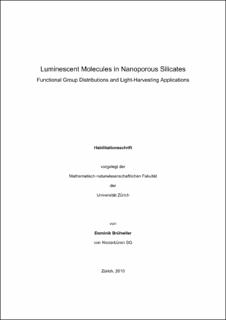Bitte benutzen Sie diese Kennung, um auf die Ressource zu verweisen:
https://doi.org/10.21256/zhaw-3512| Publikationstyp: | Habilitationsschrift |
| Titel: | Luminescent molecules in nanoporous silicates |
| Autor/-in: | Brühwiler, Dominik |
| DOI: | 10.21256/zhaw-3512 |
| Umfang: | 118 |
| Erscheinungsdatum: | 2010 |
| Verlag / Hrsg. Institution: | Universität Zürich |
| Verlag / Hrsg. Institution: | Zürich |
| Sprache: | Englisch |
| Fachgebiet (DDC): | 540: Chemie |
| Zusammenfassung: | The unique properties of the defined channel systems of nanoporous silicates, such as zeolites and mesoporous silica, are of interest for a variety of applications, including fields as diverse as catalysis, biological imaging, sensing, adsorption, and drug delivery. Appropriate functionalization of the porous host materials is the key to a successful implementation. Extending the organization provided by a given channel system to a macroscopic level, establishing an interaction with the surrounding medium, or assigning tasks to specific parts of the external and internal surfaces requires multiple degrees of modification. This important aspect of the chemistry of ordered nanoporous materials is discussed with emphasis on the synthetic and analytical challenges associated with the controlled placement of functional groups on mesoporous silica. Luminescent labeling in combination with nitrogen sorption, optical spectroscopy, confocal laser scanning microscopy, and the quantitative analysis of grafted organic moieties provides insights into the parameters that control the distribution of functional groups on mesoporous silica. The inclusion of luminescent molecules into nanoporous hosts not only serves analytical purposes, but can further lead to materials with intriguing photophysical properties, opening novel possibilities for light-harvesting applications. Obtaining high conversion efficiency at low costs is the key issue in current research on photovoltaics. Concepts that are directed towards a better use of the complete solar spectrum combined with a conversion to light of a narrow wavelength range are particularly promising in this regard. Two novel approaches that fall into this category are discussed, both based on the inclusion of luminescent molecules into the channels of zeolite L crystals. Luminescent solar concentrators employing dyezeolite antenna materials as active components have the potential to solve the selfabsorption problem that has been limiting the commercial viability of such devices for more than 30 years. Similar antenna materials with specifically designed zinc phthalocyanine acceptors are proposed for the sensitization of organic solar cells. |
| URI: | https://digitalcollection.zhaw.ch/handle/11475/2884 |
| Lizenz (gemäss Verlagsvertrag): | Keine Angabe |
| Departement: | Life Sciences und Facility Management |
| Organisationseinheit: | Institut für Chemie und Biotechnologie (ICBT) |
| Enthalten in den Sammlungen: | Publikationen Life Sciences und Facility Management |
Dateien zu dieser Ressource:
| Datei | Beschreibung | Größe | Format | |
|---|---|---|---|---|
| Bruehwiler-Habil-290610.pdf | 13.53 MB | Adobe PDF |  Öffnen/Anzeigen |
Zur Langanzeige
Brühwiler, D. (2010). Luminescent molecules in nanoporous silicates. Universität Zürich. https://doi.org/10.21256/zhaw-3512
Brühwiler, D. (2010) Luminescent molecules in nanoporous silicates. Zürich: Universität Zürich. Available at: https://doi.org/10.21256/zhaw-3512.
D. Brühwiler, Luminescent molecules in nanoporous silicates. Zürich: Universität Zürich, 2010. doi: 10.21256/zhaw-3512.
BRÜHWILER, Dominik, 2010. Luminescent molecules in nanoporous silicates. Zürich: Universität Zürich
Brühwiler, Dominik. 2010. Luminescent Molecules in Nanoporous Silicates. Zürich: Universität Zürich. https://doi.org/10.21256/zhaw-3512.
Brühwiler, Dominik. Luminescent Molecules in Nanoporous Silicates. Universität Zürich, 2010, https://doi.org/10.21256/zhaw-3512.
Alle Ressourcen in diesem Repository sind urheberrechtlich geschützt, soweit nicht anderweitig angezeigt.